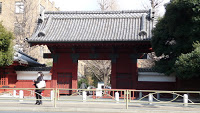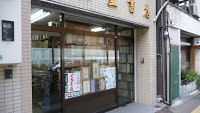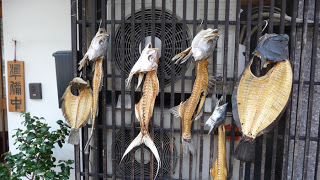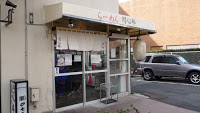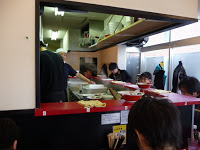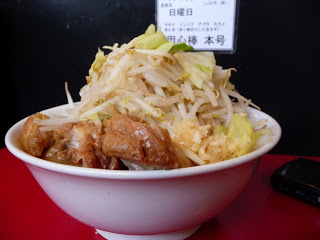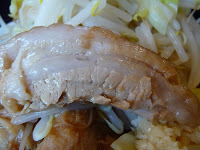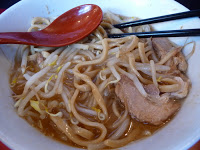Hongo Sanchome – a curious neighborhood. On one hand, the well-educated or at least well-traveled among you will recognize this as the famous red gate of Tokyo University (Todai), the ‘Harvard of the East’ (or the ‘Wesleyan of Wa‘ if you prefer),
and the neighborhood is roughly jumbled with used book and expensive antique stores. Musty classics all, you’d say.
On the other hand, some shops evince a rougher sensibility.
It was a long walk up from the station; my destination is far from Hongo but right near Todaimae, a station on the Namboku line, which I like to think of as the ‘line to nowhere’, because it connects to nowhere I regularly go or really want to.
I was readying some snide comments about how Todai students are too classy to eat ramen (there isn’t much indicated on the usual sites), but in fact there are a bunch of good-looking ones – a Keisuke branch, a Ya Ya Ya (with extensive English introduction on a sign out front, including the classic direction “Please eat our ramen at least three times”), some one-offs. I guess I’ll be going back.
Yojinbo is another of them – in a neighborhood of quiet, intellectual sophistication, it’s just a semi-finished garage. An interesting point about this place is that it’s the father shop of a newer, classier branch in Jinbocho (another interesting point is that the jinbo of the shop and the jinbo of the place are totally different). I’ve walked by that one many times, both on reckies and also ever time I visit the mighty Masked Noodle. I think of that as an ‘overflow’ place – it usually has a short line, but nothing like the block-spanners frequently seen across the street at the Ramen Jiro branch (which is one of the most popular of the 30+ Jiros in the world (which are not branches, more like approved child shops, I think)). Yojinbo could be fairly described as a ‘Jiro clone’. It could also be fairly described as ‘popular’, ranking 138th on ramendb out of 31,600 listed shops (the branch is 121st, for what it’s worth). This puts it at roughly the same level as 69 ‘n’ Roll.
Well, that’s a prelude by way of a segue. I didn’t have to wait, but that was accidental – this place has the buzz of a ramen-ya that stays full from opening to closing.
Did I say already that this my first time to eat Jiro-kei ramen? Well, this was the point where I showed my newness by trying to specify what toppings I wanted as I sat down. Ramen Tokyo describes the procedure accurately and in detail, and as soon as the guy snapped “Wait your turn,” I remembered this. Fortunately plenty of other people were lax in their ordering too, and they could actually read the signs.
Yes, this was my first time to eat Jiro-kei ramen. I get it now. It’s a really good style. Not that this is a big news flash to any of the millions of people that love it. Well, million. Thousands. A lot of people, OK?
The salient features are the mountain of bean sprouts and cabbage (lightly boiled en masee and then drained in a laundry tub that’s all melted on one side from flying too close to the sun; there’s a special word for this), the garlic (at least 3 good-sized cloves, crushed and thrown in here; there’s a cute little ritual where they ask every customer “Would you like garlic?” I was pretty in the spirit, and it was hard for me to resist making a joke playing on Nate’s post on his visit to the Jiro mothership, something like “Oh, is it good with garlic?” They already didn’t like me after I ordered out of turn; the correct answer to “Would you like garlic” is your preferred topping list, so you could actually say “Yes, garlic extra vegetables spicy added fat.”.), the soup, which is a half-thick tonkotsu…
the pork, which is a whole lotta fatty meat, or meaty fat if you prefer, cooked very very soft. I think I got the recommended extra pork version as well; everything is cheap here.
And the noodles. Evidently Jiro-kei ramen is proud of its noodles, and justifiably so based on this. They’re big and very firm, not at all in the squishy-chewy udon mold, and have a terrific bold taste, almost like whole wheat to me. I think Jiro-kei is basically the pork and the noodles, plus the overall veggie-mountain shape of the meal.
This picture shows the combined elements but also reflects my progress through the bowl; Ramen Tokyo describes the difficulty of finishing a bowl of Jiro-kei ramen, and I gave up the ghost shortly after this. Come to think of it, this is a good ‘health’ strategy – I got extra vegetables, and by the time I ‘climbed sprout mountain’ I was already half full. I’d eat this stuff again though; it would be interesting to see if this is a good example of Jiro-ism or if there are even better ones. I had a full and satisfied feeling as I embarked on the long walk back to the station. No, make that “I felt woozy and a little sick,” because that’s how it really was.
Can’t help it, any time I hear the name, I think of Jack Wade in the Bond movies saying “Yo! Jimbo!”
03-3817-0120
